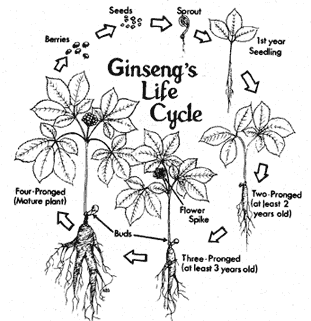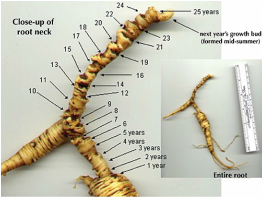Ginseng Life Cycle
|
American ginseng, Panax quinquefolius, is one of the most valuable medicinal herbs. Although it is a rather ordinary looking little plant that grows inconspicuously on the floor of hardwood forests throughout northeastern North America, its value lies buried in its slow-growing tuberous rootstock.
There are two main types of ginseng: Asian or Korean ginseng (Panax ginseng) and American ginseng (Panax quinquefolius). They are members of the ancient Araliaceae family and have similar chemical compositions, but they are used differently in traditional Chinese medicine. The Asian or Korean ginseng originates from northeast China, Korea, Manchuria and extreme eastern Russia near the Chinese border. American ginseng is produced in the United States and Canada. Ginsenoside Content Comparison Two important measures of ginseng root quality are ginsenoside and polysaccharide content. Ginsenosides are a complex mixture of compounds called triterpene saponins and polysaccharides are a mixture of complex sugars. These chemical compounds are affected in both quality and quantity by the production practices employed by growers. American ginseng contains more of the ginsenosides better suited to adapt to and cope with stress. For both types of ginseng, the age, growing conditions, genetic makeup of the seeds and where and how it was grown affect the number of ginsenosides available. The ginsenosides consistently associated with American ginseng are: Rb1, Rb2, Rc, Rd, Re, Rg1, Ro; the malonyl-ginsenosides: mRb1, mRb2, mRc, mRd, and gypenoside XVII. One of the distinguishing features of North American ginseng is the absence of ginsenoside Rf which is present in Asian ginseng. |
How to Identify the Age of Ginseng?
|
Ginseng also has a few evolutionary surprises. Ginseng's stem is actually found below ground. During the growing season, this structure, known as a rhizome, develops a bud that will grow into the next year's visible ginseng plant. Each fall, the foliage dies and the base of the stem breaks off just below ground level, leaving a scar on the rhizome at the top of the root. This yearly scarring produces a root 'neck', technically called a rhizome, which bears a series of alternating and ascending marks that indicate the age of ginseng.
Rhizomes can also be used (along with seeds) to propagate plants and in fact many ginseng harvesters in the past used to plant the rhizomes at harvest to ensure continuation of the population. The age requirement can have the negative effect of preventing one means of ensuring continuation of the population. Since the rhizome produces a clone of the parent plant, this mode of reproduction aids in the propagation of already-successful genotypes. |


